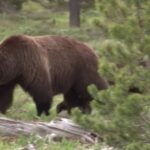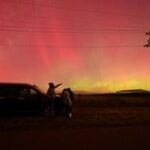Eldon Eugene Diettert was looking forward to celebrating his 19th birthday with his family in Missoula on August 5, 1949, when word came that there was a fire in the Gates of the Mountains Wild Area northeast of Helena. Diettert was not supposed to work that day, but another member of the recently formed U.S. Forest Service smokejumping crew in Missoula was out sick, so he was told to report to the airport. His mom’s famous birthday cake would have to wait.
But that birthday celebration would never come. A few hours after taking off from Missoula, Diettert and 12 others would perish in an inferno that would change wildland firefighting forever.
This weekend, a series of events in Helena will mark 75 years since the Mann Gulch Fire, the single deadliest day in the history of smokejumping. The fire inspired Norman Maclean’s award-winning book, “Young Men and Fire,” but more importantly it had a profound impact on how wildfires are managed and fought, leading to a set of rules that all wildland firefighters still carry with them three-quarters of a century later.
TRAGEDY AT MANN GULCH
Diettert was born on August 5, 1930, in Moscow, Idaho, the second son of Reuben and Charlotte Diettert. Reuben was a professor and as a result, the family moved a number of times, eventually ending up in Missoula, where he worked for the University of Montana’s botany department. As a boy, Diettert and his brother Gerald would sell magazines and do whatever they could to help the family out financially. When he was old enough, Diettert worked for the U.S. Forest Service, and it was there that he decided he wanted to pursue a forestry degree. In 1949, he applied to join the smokejumpers.
Smokejumping was a relatively new craft, emerging in the 1930s as a way to quickly get firefighters into remote territory to douse blazes. At the time, the USFS subscribed to what it called the “10 a.m. policy” where it attempted to suppress every fire reported by 10 a.m. the next day, an all-or-nothing method of firefighting that did not consider the role of fire on the landscape. Missoula was, and still is, the largest smokejumper base in the country.
In the spring and early summer of 1949, Diettert did practice jumps around western Montana, many of which he recorded in sketches and letters to his family. But he wasn’t called on a fire until the afternoon of August 5, the day of his 19th birthday.
The lightning-caused Mann Gulch Fire had started the previous day northeast of Helena and by mid-day on Aug. 5, it had already burned about 60 acres. Early that afternoon, the local forest supervisors decided to call in smokejumpers. At 2:30 p.m., a C-47 military transport aircraft departed Missoula with a crew of 16 smokejumpers, including Diettert. A little over an hour later, they were approaching the fire, but turbulence was an issue and one smokejumper got so sick he couldn’t make the jump.
By 4 p.m., 15 jumpers were on the ground, but during their jump, their equipment had been scattered across the mountainside, and their radio, their only connection to the outside world, was destroyed. As the jumpers gathered their equipment, wind gusts up to 40 miles per hour began to fan the flames in the canyon along the Missouri River. The crew began to hike uphill to safety, but the fire only grew more intense.
Foreman Wag Dodge yelled to his crew to drop their equipment and run, but it was too late. By then, the wind was pushing the fire up the hill at a rate of hundreds of feet per minute. Realizing the men weren’t going to outrun it, Dodge did something never attempted before: He set a new fire and laid down in the ashes — “the black” — in a last-ditch effort to save himself. While he yelled for others to join him, no one did. Moments later, the fire overran the rest of the crew, killing 12 smokejumpers and a fire warden. Only Dodge and two other firefighters who sheltered in a crevice in the canyon’s rock wall survived.
In the hours and days that followed, word of the tragedy began to spread and families learned of their loved one’s fate. Among them was the Diettert family in Missoula. In a family history written years later, Gerald Diettert would recall the moment he learned his brother was dead.
“I recall vividly Mother running out of the front door where the rest of the family waited to hear about Eldon’s whereabouts,” he wrote. “‘He’s gone! He’s gone!’ she screamed in anguish.”
A LASTING IMPACT
Diettert’s parents did not talk much about their son’s death, but Gerald made sure to tell his own children about his brother and the sacrifice he made at Mann Gulch. Gerald’s daughter, Carol Diettert-Knieper, said the family would put flowers at his grave every Memorial Day.
“I never knew my uncle, but my father and family always tried to keep his memory alive,” Diettert-Knieper recently told Montana Free Press. “It’s such a sad story. A real tragedy.”
Diettert-Knieper said that years later when cleaning out her grandparents’ home, the family found a box labeled “Mann Gulch” that included many of Diettert’s possessions from his time in the Forest Service, including letters he had written the family in the summer of 1949.
The Mann Gulch Fire was the deadliest in the history of the smokejumper program, and it had a lasting impact on how wildfires are fought. The incident taught the Forest Service that it needed to better understand fire behavior, and as a result, it opened a wildfire research facility in Missoula. An effort was also made to provide firefighters with better safety equipment, perhaps most notably personal fire shelters introduced in 1959 and made mandatory in 1977.
“I never knew my uncle, but my father and family always tried to keep his memory alive. It’s such a sad story. A real tragedy.”
Carol Diettert-Knieper
But maybe Mann Gulch’s most iconic result was the creation of the “Ten Standard Firefighting Orders.” Among those rules are the requirement to always post a lookout to know what the fire is doing, to always identify escape routes and to always maintain lines of communication. Chiara Cipriano, public affairs officer for the Helena-Lewis & Clark National Forest, said those rules are prominently written on the back of the guidebook that every new firefighter is given.
“This is always one of the first fires that new firefighters learn about when getting their red card,” she said.
The Forest Service is hosting a series of events this weekend to mark the 75th anniversary of the fire. On Saturday, August 3, there will be a showing of the documentary “Higgins Ridge” at the Myrna Loy Theater in Helena. The program focuses on a fire that occurred a decade after Mann Gulch with eerie similarities. On Aug. 4, a hike will be hosted to the site of the York Fire, one of the other fires that started from that lightning storm 75 years ago. Then from 2 to 5 p.m., an event will be held at the Helena Walking Mall with displays about the fire and the unveiling of a commemorative beer from Ten Mile Creek Brewing.
Finally, on Aug. 5, from 4 to 7 p.m., a memorial event will be held at the Capitol. Officials from the USFS will give remarks and John N. Maclean (son of Norman Maclean) will give the keynote address. Weather permitting, the Miss Montana, the same C-47 plane that dropped the smokejumpers in 1949, will pass over the event. Additionally, graveside memorials will be hosted for three firefighters from northwest Montana on Aug. 8 in Kalispell and Aug. 10 in Ronan. For more information about the public events in Helena, visit this website.
More than 70 family members, including Eldon Diettert’s niece, Carol Diettert-Knieper, are expected to attend the events in Helena. Like so many, Diettert-Knieper said the events of Aug. 5, 1949, had a profound impact on her family. Even 75 years later, it’s nearly impossible not to ask, “What if?”
“We’ve always wondered what my uncle would have been like if he had survived,” she said. “How would he have changed our family dynamic?”

In-depth, independent reporting on the stories impacting your community from reporters who know your town.
LATEST STORIES
Education leaders take stock of changes to school quality requirements
Montana education officials spent more than a year revising the state’s process for measuring the quality of its public schools. But technical glitches and additional reporting requirements have prompted some superintendents to criticize the changes as time-consuming and onerous.
Summertime is fritter time
This garden fritter recipe honors Montana gardeners and farmers with a tasty Montana commodity we have in abundance: red lentils. In this recipe, these decorticated (i.e., husks removed) pulses are soaked for at least two hours, blended with a few aromatics, and thus transformed into a delicious and nutritious binder for the abundant zucchini and summer squash that neighborhood gardeners are often eager to give away at peak harvest.
Three questions for VACOM Montana’s general manager in Lewistown
German industrial equipment company VACOM chose Lewistown as the site for its first U.S. manufacturing center, a development that the company has said could create 200 jobs in the 6,000-person city as soon as 2027. Montana Free Press spoke with VACOM Montana General Manager Marcel Klessen, who relocated his family to Lewistown earlier this summer, about the company’s plans and how it hopes to fit its operation into the rural Montana community.





